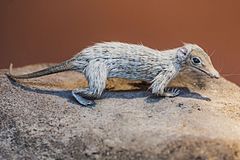Megazostrodon
| Megazostrodon Temporal range:
| |
|---|---|

| |
| Megazostrodon model, Natural History Museum, London | |
| Scientific classification | |
| Domain: | Eukaryota |
| Kingdom: | Animalia |
| Phylum: | Chordata |
| Clade: | Synapsida |
| Clade: | Therapsida |
| Clade: | Cynodontia |
| Clade: | Mammaliaformes |
| Order: | †Morganucodonta |
| Family: | † Megazostrodontidae
|
| Genus: | †Megazostrodon Crompton & Jenkins, 1968[1] |
| Type species | |
| †Megazostrodon rudnerae Crompton & Jenkins, 1968[1]
| |
| Other species | |
| |
Megazostrodon is an extinct genus of basal
Discovery
The type species M. rudnerae was first discovered in 1966 in the Elliot Formation of Lesotho, southern Africa, by palaeontologist and archaeologist Ione Rudner. It was first described by A.W. Crompton and F.A. Jenkins Jr in 1968.[1] The generic name Megazostrodon means, literally, ‘large girdle tooth’ (from the Greek mega-large, zostros-girdle and don-tooth — referring to the large external cingula of the upper molars). The specific name honours Rudner for her discovery.[4]
A second species, M. chenali, was named in 2015 based on remains found in Saint-Nicolas-de-Port, France. It is named after the French palaeontologist Emmanuel Chenal.[2]
Characteristics
Megazostrodon was a small,
Although considered a close relative of mammals, it did have some non-mammalian characteristics inherited from its predecessors: the first two vertebrae (atlas and axis) were still unfused as in earlier cynodonts, and it only had three sacral vertebrae instead of the usual mammalian five.
Evolution
Megazostrodon is the best-known genus of the family
These early mammaliaforms possessed many traits which made them well-suited for an active lifestyle. They had a
Probably the most important change in the evolution of the first mammals was that their ancestors, the cynodonts, had become endothermic. This meant that they generated their own body heat, relying on the food they ate to help sustain their body temperature rather than depending on their surrounding environment. This permitted higher, more sustained activity levels during the day than reptiles (reptiles must frequently perform temperature regulation activities such as sun basking and seeking shade). It was probably the key to becoming nocturnal — a major advantage in a world where most predators were active during the day.
- Phylogeny[11]
| Mammaliaformes |
| ||||||||||||||||||||||||||||||||||||||||||
Reproduction
Like
See also
References
- ^ S2CID 1044399.
- ^ S2CID 84966194.
- ^ a b c Fur and Fangs: Mammal Origins Archived 2011-06-05 at the Wayback Machine. Palaeobiology and Biodiversity Research Group, University of Bristol.
- ^ Dinosaur Mailing List
- ^ Smithsonian Science Abstract
- ^ Kemp, The Origin and Evolution of Mammals, (2004). Oxford Univ. Press, p. 146.
- ^ Mammalogy Archived 2006-10-27 at the Wayback Machine Sam Houston State University.
- ^ a b First Mammals Appear
- ISBN 0-8160-1194-X.
- ^ Mammalian Characteristics. Sam Houston State University.
- PMID 26190074.
- ^ Jason A. Lillegraven, Zofia Kielan-Jaworowska, William A. Clemens, Mesozoic Mammals: The First Two-Thirds of Mammalian History, University of California Press, 17/12/1979 – 321
